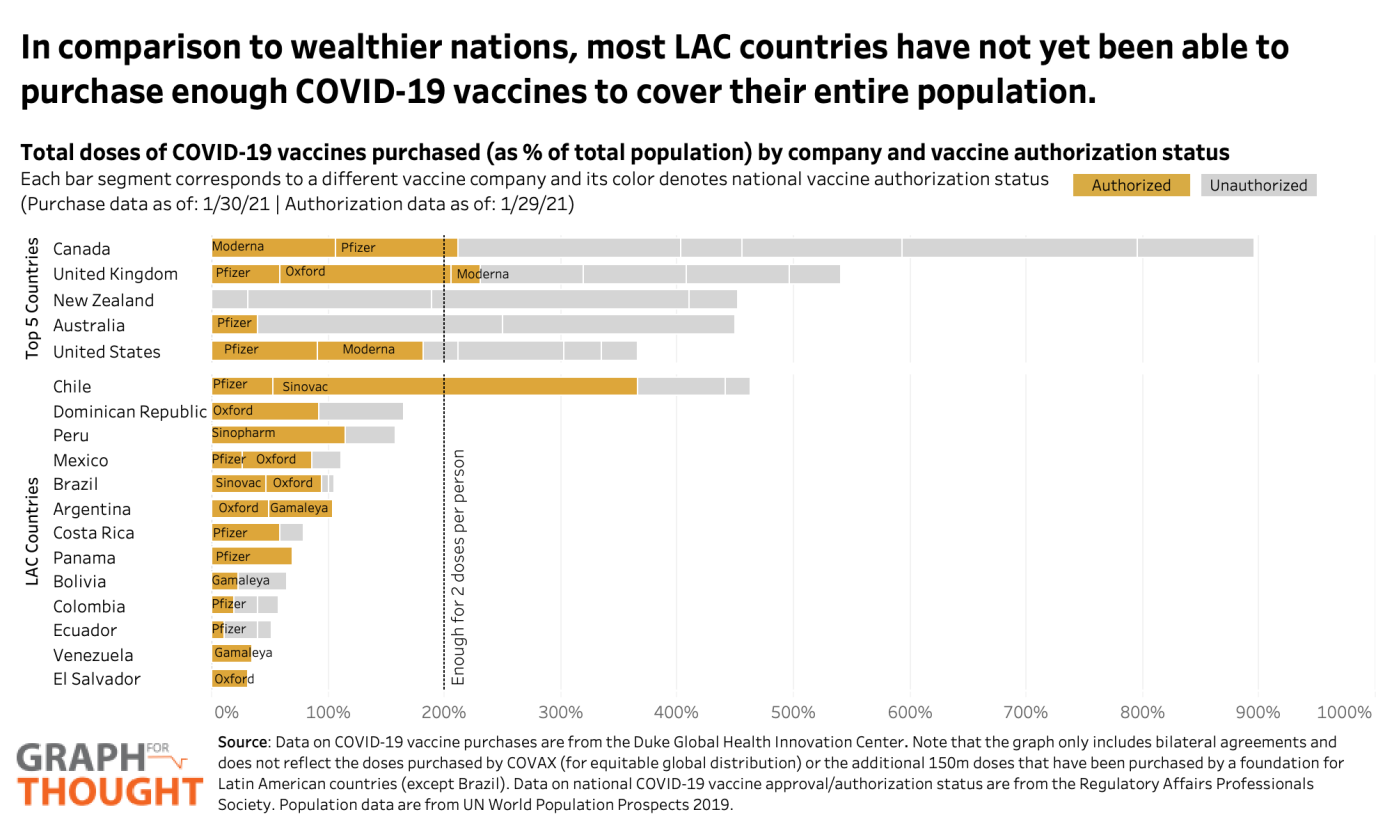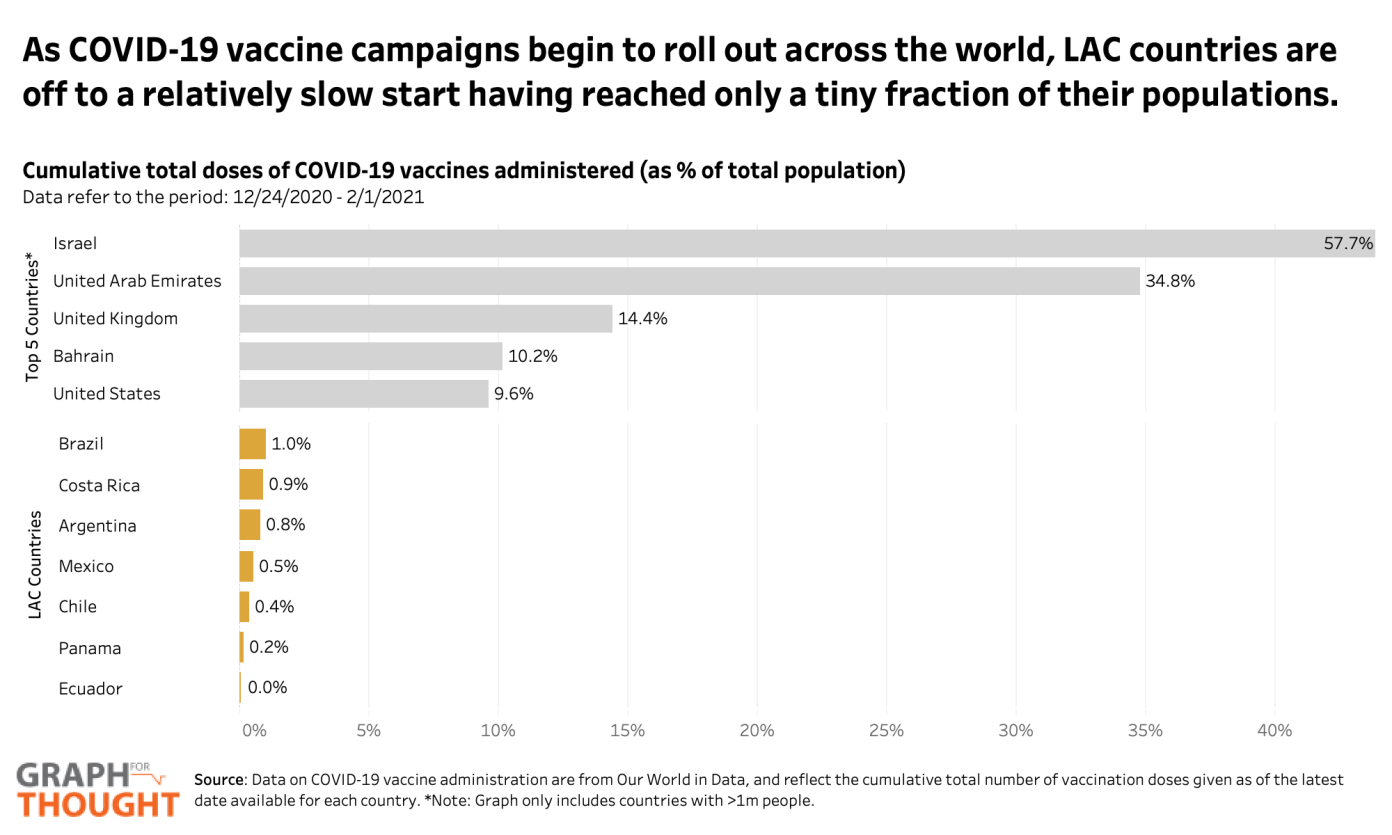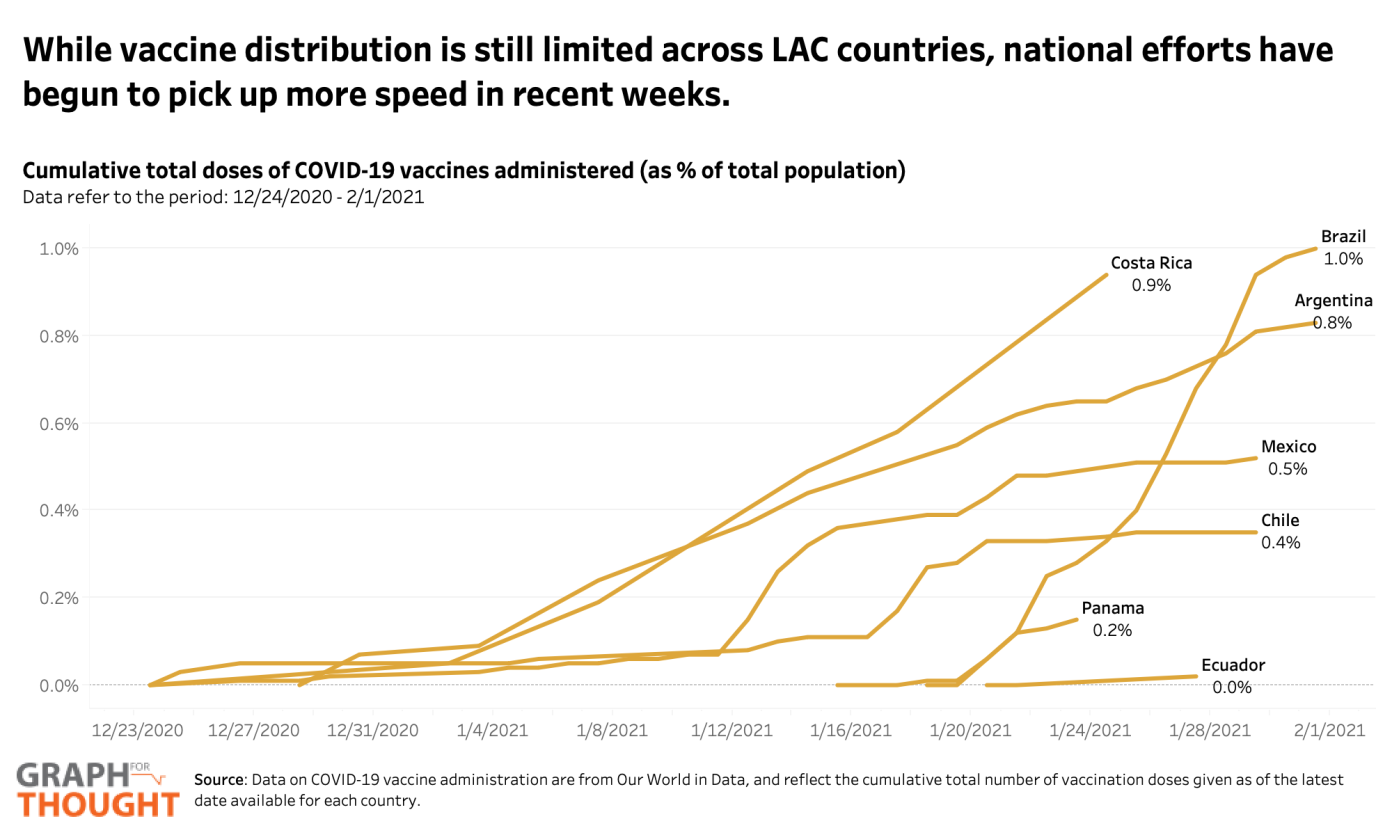Racing against the virus: An early look at the state of COVID-19 vaccination campaigns in LAC
February 2, 2021
After a long year of loss and hardship induced by the multiple crises of the pandemic, the highly anticipated arrival of COVID-19 vaccinations promised the hope of finally being able to put an end to this difficult chapter in our history. Indeed, the incredible collaboration of scientists with both public and private sector actors has achieved the great feat of developing, testing, and approving vaccinations in record time.
However, while we have surmounted this first technical hurdle—the race against the virus is far from over. Now that we have the technology to develop the vaccines, we must also ensure we have the fiscal capacity to purchase them, the manufacturing capacity to produce them, the logistical capacity to deliver them, and the administrative capacity to administer them—and to ensure that these efforts lead to the equitable vaccination of people everywhere. While vaccination efforts have just begun to take off globally, this #GraphForThought looks at the data on vaccination procurement and vaccination administration in the LAC region to offer an early look at the current state of affairs.
Before countries can begin administering doses of the vaccine, they must first purchase them from the companies that have developed them. Using data (as of January 30, 2021) from the Duke Global Health Innovation Center’s Launch and Scale Speedometer, which has been aggregating publicly available data on vaccine procurement contracts by country and company, we see that through Advanced Market Commitments wealthier countries have been able to reserve the majority of vaccine doses (hedging their bets across a range of potential vaccine candidates). In the graph below, we see what this looks like in LAC countries in comparison to the Top 5 (non-LAC) countries in terms of vaccine dose purchases (as % of population). Based on data (as of January 29, 2021) from the Regulatory Affairs Professionals Society’s COVID-19 vaccine tracker, the graph also shows which of those vaccines purchased have actually be authorized for use in that country (authorized vaccines are shown in yellow).
In comparison with wealthier countries, most LAC countries (with the exception of Chile), have not been able to secure enough potential vaccines to cover their entire population—a fact which becomes starker when those purchases are restricted to only those vaccines that are currently authorized for use. At this point in time, only Canada and the UK have purchased enough of nationally authorized vaccines to be able to administer 2 doses to every person. Within the LAC region, Chile has purchased the most potential vaccines per capita, as well as the most currently authorized vaccines per capita (enough to administer 2 doses to every person). This situation is changing daily though—as countries continue to negotiate new purchase contracts and as more vaccines are approved to meet national authorization standards.

It is important to note that purchasing vaccines is not just a question of the upfront cost of the doses. Negotiations of contracts require many challenging agreements—including the allocation of risk regarding liability for vaccine side effects (will it fall on national governments or pharmaceutical companies?) as well as how logistical companies will be contracted for delivery services (which companies will be considered to meet the technical requirements for transport of the vaccines?). Finally, the ability to purchase large reserves of vaccines in advance ensures that richer countries will have earlier access to vaccines, given the limited global manufacturing capacity to produce them (though notably, Argentina, Brazil, and Mexico have signed contracts to manufacture vaccines in the region). Estimates predict that it may take until late 2023 to produce enough vaccines for the whole world. To combat this massive challenge of equity, global mechanisms such as COVAX (led by GAVI, WHO, and CEPI) are playing a critical role in expanding access for poorer countries—and most countries in the LAC region have joined this global facility. Four countries in the LAC region (Bolivia, Colombia, El Salvador, and Peru) were recently notified by COVAX that they will be part of the “first wave” of dose distributions (jointly receiving a total of 377,910 doses, expected to arrive beginning mid-February). Other organizations, such charitable foundations, are also providing funding to expand access—in LAC, for example, the Carlos Slim Foundation negotiated an agreement with AstraZeneca to provide 150 million vaccine doses to Latin American countries (with the exception of Brazil).
Even once vaccines have been purchased and manufactured, they need to be delivered and then administered. Using data (as of February 1, 2021) from Our World in Data, we can see how quickly countries are deploying vaccine doses to their population. Israel stands out as having by far the most rapid vaccine rollout globally—already having administered a number of doses equivalent to more than half the country’s population. This has largely been made possible due to the country’s existing underlying public health infrastructure. As the graph below shows, Israel is followed in the Top 5 countries by the UAE, UK, Bahrain, and the US—all having administered a number of doses equivalent to more than 9% of their population. LAC countries are currently trailing far behind—with vaccines only reaching a tiny fraction of their population thus far. Brazil and Costa Rica currently lead in the region, having respectively administered vaccine doses equivalent to 1% and 0.9% of their populations.

It is important to note however, that vaccine campaigns are just beginning in the LAC region. As the graph below shows, while total coverage of vaccination efforts is still very low—they are picking up speed in recent weeks and more countries in the region have joined in this race against the virus. Efforts will need to continue to accelerate, however, if we are to put a timely end to this crisis. There are currently 58.7 million people over the age of 65 living in LAC. In order to vaccinate just this age group (providing 2 doses to each person) within the span of one full calendar year, countries in the region would need to collectively vaccinate 321,376 people per day. On the most recent day with data available (February 1, 2021)—countries in the region collectively vaccinated a total of 50,284 people. Though, thus far, these efforts are still only concentrated in a few countries in the region.

To truly defeat COVID-19 will require universal vaccination efforts. Importantly, this must not only happen across countries (considering equity dimensions between richer and poorer nations) but also critically within countries (considering equity dimensions between different groups of people and existing barriers to healthcare access). We must ensure that people everywhere have equal access to this vaccine—we must ensure that no one is left behind. Only then will LAC countries be able to recover and we will be successful in our fight against this pandemic.

 Locations
Locations